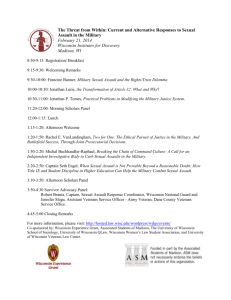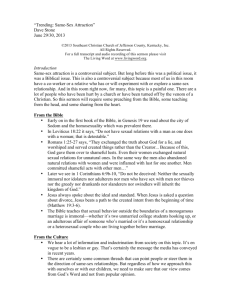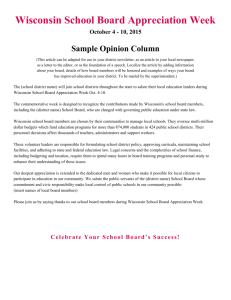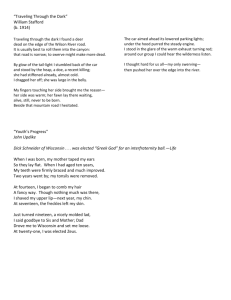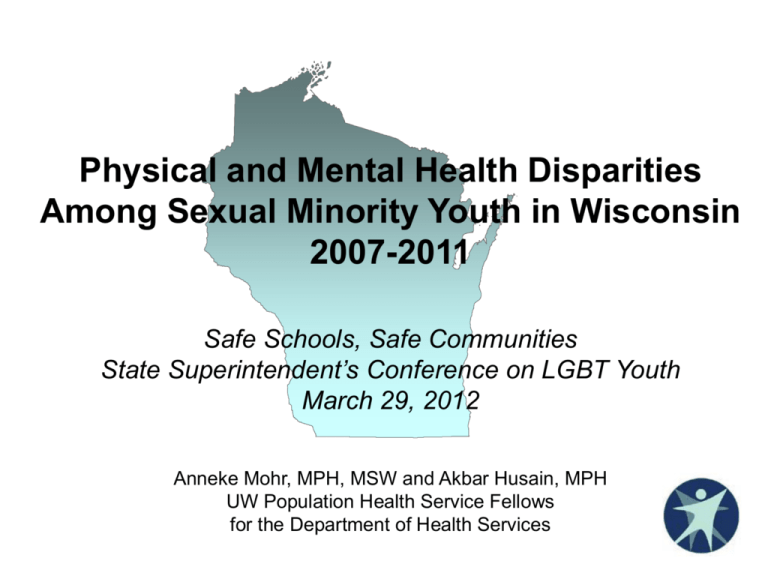
Physical and Mental Health Disparities
Among Sexual Minority Youth in Wisconsin
2007-2011
Safe Schools, Safe Communities
State Superintendent’s Conference on LGBT Youth
March 29, 2012
Anneke Mohr, MPH, MSW and Akbar Husain, MPH
UW Population Health Service Fellows
for the Department of Health Services
Overview
1.
National and state climate
2.
Youth Risk Behavior Survey (YRBS)
3.
Sexual minority demographics
4.
Healthiest Wisconsin 2020 (HW2020)
5.
Data by HW2020 health focus area
6.
Implications
7.
Questions
Wisconsin Department of Health Services
Acknowledgments
•
Mari Gasiorowicz, Epidemiologist, DHS
•
Chitra Kakri, Data Analyst, formerly of DHS
•
Gary Hollander, Executive Director, Diverse & Resilient
•
Emily Holder, Consultant- Coordinated School Health
Programs, DPI
•
Ron Gangon, Assistant Professor, UW School of Medicine
& Public Health
•
Michigan YRBS Analysis Team
Wisconsin Department of Health Services
1. NATIONAL AND STATE CLIMATE
Wisconsin Department of Health Services
National Climate
• Suicides on the rise among
LGBTQ youth
• Bullying contributes to suicides
• Celebrities offer support to
LGBTQ youth
Wisconsin Department of Health Services
State Climate
The Wisconsin Research Brief based on
GLSEN’s 2009 National School Climate
Survey found that:
– 55% of schools had a Gay-Straight
Alliance
– 55% had LGBT library resources
– 24% had comprehensive
bullying/harassment policy
– 18% had inclusive curriculum
“Students attending
schools with these
resources and
supports report
lower victimization
and absenteeism
and higher academic
achievement”
Source: Gay, Lesbian, and Straight Education Network (GLSEN)
http://www.glsen.org/binarydata/GLSEN_ATTACHMENTS/file/000/001/1825-2.pdf
Wisconsin Department of Health Services
2. YOUTH RISK BEHAVIOR SURVEY (YRBS)
AND
LGBT DATA COLLECTION
Wisconsin Department of Health Services
Youth Risk Behavior Survey
• Coordinated every other year by
– Administered at state & local level
– Middle and high schools
• States can add optional questions to identify
sexual minorities
• In 2011 the CDC released
Sexual Identity, Sex of Sexual Contacts, and Health-Risk Behaviors
Among Students in Grades 9-12 – Youth Risk Behavior
Surveillance, Selected Sites, United States, 2001-2009
http://www.cdc.gov/mmwr/preview/mmwrhtml/ss60e0606a1.htm
Wisconsin Department of Health Services
“Sexual Minority” an umbrella term for…
1. Behavior
•
Men who have sex with men (MSM), women who have sex with women (WSW)
During your
1.
2.
3.
life, with whom have you had sexual contact?
Females
Males
Females and males
2. Attraction
•
Attracted to same-sex, opposite-sex only, or both sexes
3. Sexual identity
•
Lesbian, gay, bisexual, queer, or questioning (LGBQ)
Which of the following best describes you?
1. Heterosexual (straight)
2. Gay or lesbian
3. Bisexual
4. Not sure
4. Gender identity
•
•
Transgender (Born male, identify as female or born female, identify as male)
Genderqueer (Identify as neither female nor male)
Wisconsin Department of Health Services
Sexual Minority Questions
Wisconsin High School YRBS
Year
Sexual Minority item(s) asked
2007
Behavior
2009
Behavior
2011
Behavior
+ Sexual identity
• Gender identity not currently asked in any state
• Adding sexual minority questions was a collective effort
between Diverse & Resilient, DPI, and DHS
Wisconsin Department of Health Services
2009: Sexual Minority Questions on YRBS in
12 States, 6 Districts
Boston
Milwaukee
New York City
Chicago
San Francisco
Los Angeles
YRBS asks about:
Same-sex sexual behavior (3 SEAs, 1 LEA)
LGB identity (2 SEAs, 1 LEA)
Both behavior and identity (6 SEAs, 4 LEAs)
Same-sex attraction (1 SEA)
SEA – State Education Agency LEA – Local Education Agency
Wisconsin Department of Health Services
2011: Sexual Minority Questions on YRBS in
15 States, 10 Districts
Seattle
Milwaukee
Boston
Detroit
New York City
Chicago
San Francisco
Los Angeles
San Diego
Houston
YRBS asks about:
Same-sex sexual behavior (4 SEAs, 1 LEA)
LGB identity (1 SEA, 1 LEA)
Both behavior and identity (10 SEAs, 8 LEAs)
SEA – State Education Agency LEA – Local Education Agency
Wisconsin Department of Health Services
3. SEXUAL MINORITY
DEMOGRAPHICS IN THE YRBS
Wisconsin Department of Health Services
Percent of sexually-active students who have
had same-sex contact,
Wisconsin YRBS, 2007-2011
Same-sex
contact*
9.9%
Same-sex contact
2007: 8.6% (111/1292)
Opposite-sex
contact only
90.1%
2009: 9.9% (138,1393)
2007-2011
2011: 11.1% (177/1599)
2007-2011: 9.9% (428/4288)
* Students with same-sex contact may also have had opposite-sex contact.
Source: Wisconsin YRBS
Wisconsin Department of Health Services
Students who have had same-sex contact,
by sex of respondent and partners,
Wisconsin YRBS, 2007-2011
n=428
Bisexual behavior 69%
Same-sex only 31%
F e m a le s wit h f e m a le s a nd
m a le s
52%
Females - 66%
Males - 34%
M a le s wit h m a le s o nly
17 %
M a le wit h m a le s
a nd f e m a le s
17 %
F e m a le s wit h f e m a le s o nly
14 %
2007-2011
* Students with same-sex contact may also have had opposite-sex contact.
Source: Wisconsin YRBS
Wisconsin Department of Health Services
Percent of sexually-active students
who have had same-sex contact,
Milwaukee YRBS, 2007-2011
Same-sex
contact*
13%
Same-sex contact
Opposite-sex
contact only
87%
2007: 13.7% (171/1248)
2009: 12.4% (151,1219)
2007-2011
2011: 14.1% (175/1241)
2007-2011: 13.4% (497/3708)
* Students with same-sex contact may also have had opposite-sex contact.
Source: Milwaukee YRBS
Wisconsin Department of Health Services
Sexual orientation, Wisconsin YRBS, 2011
n=2,707
Lesbian/Gay
1%
Bisexual
5%
Not sure
2%
8% identify as
LGB or unsure
2007-2011
Heterosexual
92%
Source: Wisconsin YRBS
(n = 4,288)
2011
Wisconsin Department of Health Services
Sexual orientation by sex of respondent,
Wisconsin YRBS, 2011
n=232
64% (148/232)
120
Lesbian or Gay
100
102
Bisexual
Unsure
80
36% (84/232)
60
36
40
31
29
19
15
20
0
Male
Source: Wisconsin YRBS
Female
Wisconsin Department of Health Services
Sexual orientation, Milwaukee YRBS, 2011
n = 1,823
Lesbian/Gay
Bisexual
3%
9%
Not sure
3%
15% identify as
LGB or unsure
Heterosexual
85%
Source: Milwaukee YRBS
2011
Wisconsin Department of Health Services
4. HEALTHIEST WISCONSIN 2020
Wisconsin Department of Health Services
Healthiest Wisconsin 2020
Ten year plan with two major goals:
1. Improve health across the lifespan
2. Reduce disparities
12 Health Focus Areas*:
1.
2.
3.
4.
5.
6.
7.
Alcohol and Drug Use
Injury and Violence Prevention
Mental Health
Nutrition and Healthy Foods
Physical Activity
Reproductive and Sexual Health
Tobacco Use and Exposure
8.
9.
10.
11.
12.
Chronic Disease Prevention and Management
Communicable Disease
Environmental and Occupational Health
Healthy Growth and Development
Oral Health
*The YRBS asks questions related to the 7 bolded items
Wisconsin Department of Health Services
Healthiest Wisconsin 2020
Vulnerable population groups
• Race and ethnicity
• Sexual orientation and gender identity
• Socioeconomic status
• Disability status
+ Geography
Wisconsin Department of Health Services
5. SEXUAL MINORITY DATA BY
HW2020 HEALTH FOCUS AREA
1. Alcohol and Drug Use
2. Injury and Violence Prevention (Bullying)
3. Mental Health
4. Nutrition and Healthy Foods
5. Physical Activity
6. Reproductive and Sexual Health
7. Tobacco Use
Bonus: Protective Factors
Wisconsin Department of Health Services
Methods
Software: SAS 9.2
Sample: 2007-2011 - Behavior - Students who report sexual contact
2011 - Identity - All students
Analysis: 1) Weighted percent
-Accounts for sampling to make results generalizable to population
2) Unadjusted Odds Ratio (OR)
-Based on sample only, not adjusted to generalize to population
-Reference group (the majority) has an odds of 1
2007-2011 - Opposite sex
2011 - Heterosexual
-The further from 1 the OR for sexual minority, the greater the disparity
-An OR of <1 means the item is less likely for sexual minorities
Wisconsin Department of Health Services
1. Alcohol and Drug Use
Figure 1. Lifetime alcohol and drug use among students with same-sex vs.
opposite-sex only sexual contact, 2007-2011
100
Weighted percent
90
89 88
80
70
70
60
54
50
Same-sex
40
Opposite-sex
31
30
20
19
20
8
10
12
13
4
8
0
Alcohol
Marijuana*
Cocaine*
Inhalant*
Meth*
Ecstasy*
*Statistically significant difference between students with same-sex and opposite-sex only sexual contact
Source: Wisconsin YRBS
Wisconsin Department of Health Services
1. Alcohol and Drug Use
6.0
Figure 2. Unadjusted odds ratio of alcohol and drug use among students
with same-sex vs. opposite-sex only sexual contact, 2007-2011
Unadjusted Odds Ratio
5.0
3.9
3.8
4.0
3.2
3.0
3.0
2.1
2.0
Odds for
same-sex
youth
1.1
1.0
Odds for
oppositesex youth
m
ph
eta
sy
*
M
eth
am
In
Ec
st a
ine
*
nt*
ha
la
e*
ca
in
Co
ar
iju
an
a*
M
Al
co
ho
l
0.0
*Statistically significant difference between students with same-sex and opposite-sex only sexual contact
Source: Wisconsin YRBS
Wisconsin Department of Health Services
2. Injury & Violence Prevention
35
Figure 3. School safety among students with same-sex vs. opposite-sex
only sexual contact, 2007-2011
31
Weighted percent
30
25
20
20
15
16
15
Same-sex
13
Opposite-sex
11
9
10
6
5
5
3
0
Skip school,
unsafe*
Threatened or In fight, injured*
injured with
weapon*
Hit, kicked,
punched*
Rarely/never
safe from harm*
*Statistically significant difference between students with same-sex and opposite-sex only sexual contact
Source: Wisconsin YRBS
Wisconsin Department of Health Services
2. Injury & Violence Prevention
9
Unadjusted Odds Ratio
8
Figure 4. Unadjusted odds ratios of school safety among students with
Fig. x Unadjusted odds ratios of school safety among students with samesame -sex vs. opposite-sex only sexual contact, 2007-2011
sex vs. opposite-sex only sexual contact, 2007-2011
7
6
4.8
5
Odds for
same-sex
youth
4
3
2.9
2.6
1.8
2
1
0
Skip school,
unsafe*
Threatened or
injured with
weapon*
In fight, injured*
Hit, kicked,
punched*
1.9
Odds for
oppositesex
Rarely/never safe
youth
from harm*
*Statistically significant difference between students with same-sex and opposite-sex only sexual contact
Source: Wisconsin YRBS
Wisconsin Department of Health Services
2. Injury & Violence Prevention
Figure 5. Intimate partner violence among students with same-sex vs.
opposite-sex only sexual contact, 2007-2011
40
35
35
Weighted percent
30
25
24
20
Same-sex
Opposite-sex
15
11
12
10
5
0
Hit by boy/girlfriend*
Forced into sexual activity*
*Statistically significant difference between students with same-sex and opposite-sex only sexual contact
Source: Wisconsin YRBS
Wisconsin Department of Health Services
2. Injury & Violence Prevention
Figure
6. Unadjusted
odds
ratios
of intimate
partner
violence
among
students
Fig. x Unadjusted
odds
ratios
of intimate
partner
violence
among
students
with
-sex vs. opposite-sex only sexual contact, 2007-2011
with same
same-sex
Unadjusted Odds Ratio
6
5
4.1
4
3
Odds for
same sex
youth
2.5
2
1
0
Hit by boy/girlfriend*
Forced into sexual activity*
Odds for
opposite
sex
youth
*Statistically significant difference between students with same-sex and opposite-sex only sexual contact
Source: Wisconsin YRBS
Wisconsin Department of Health Services
3. Mental Health
Figure 7. Depression and suicide risk among students with same-sex vs.
opposite-sex only sexual contact, 2007-2011
60
Weighted percent
50
Same-sex
49
Opposite-sex
42
40
33
30
28
25
20
15
13
11
10
7
2
0
Depressed*
Suicidal
ideation*
Suicide plan*
Suicide attempt* Suicide attempt
w/ injury*
*Statistically significant difference between students with same-sex and opposite-sex only sexual contact
Source: Wisconsin YRBS
Wisconsin Department of Health Services
3. Mental Health
Figure 8. Unadjusted odds ratios of depression and suicide risk among
students with same-sex vs. opposite-sex only sexual contact, 2007-2011
Unadjusted Odds Ratio
8.0
7.0
5.9
6.0
5.3
Odds
for
samesex
youth
5.0
4.1
4.0
3.0
3.9
2.8
Odds
for
opposite
sex
youth
2.0
1.0
0.0
Depressed*
Suicidal ideation*
Suicide plan*
Suicide attempt* Suicide attempt w/
injury*
*Statistically significant difference between students with same-sex and opposite-sex only sexual contact
Source: Wisconsin YRBS
Wisconsin Department of Health Services
4. Nutrition
Figure 9. Nutrition and obesity among students with same-sex vs. oppositesex only sexual contact, 2007-2011
60
56
50
Weighted percent
43
40
30
30
26
Same-sex
Opposite-sex
18
20
14
12
8
10
0
Drank 1+ soda/day
Trying to lose
weight*
Overweight
Obese
*Statistically significant difference between students with same-sex and opposite-sex only sexual contact
Source: Wisconsin YRBS
Wisconsin Department of Health Services
4. Nutrition
Figure 10. Unadjusted odds ratios of nutrition and obesity among students
with same-sex vs. opposite-sex only sexual contact, 2007-2011
Unadjusted Odds Ratio
3.0
2.5
2.0
1.7
1.5
1.7
Odds for
same sex
youth
1.3
1.2
1.0
Odds for
opposite
sex
youth
0.5
0.0
Drank 1+ soda/day
Trying to lose weight*
Overweight
Obese
*Statistically significant difference between students with same-sex and opposite-sex only sexual contact
Source: Wisconsin YRBS
Wisconsin Department of Health Services
5. Physical activity
Figure 11. Physical activity among students with same-sex vs. opposite-sex
only sexual contact, 2007-2011
60
Same-sex
Weighted percent
52
50
40
47
48
Opposite-sex
35
30
26
28
23
19
20
10
0
Active for 60+ min/day*
Attend PE 1+ days/week
Watch 3+ hours of TV
Play 3+ hours of video
games*
*Statistically significant difference between students with same-sex and opposite-sex only sexual contact
Source: Wisconsin YRBS
Wisconsin Department of Health Services
5. Physical Activity
Unadjusted Odds Ratio
2.5
Figure 12. Unadjusted odds ratios of physical activity among students with
same-sex vs. opposite-sex only sexual contact, 2007-2011
2.0
1.6
1.5
1.2
Odds for
same
sex
youth
0.9
1.0
Odds for
opposite
sex
youth
0.6
0.5
0.0
Active for 60+ min/day* Attend PE 1+ days/wk Watch 3+ hours of TV
Play 3+ hours video
games*
*Statistically significant difference between students with same-sex and opposite-sex only sexual contact
Source: Wisconsin YRBS
Wisconsin Department of Health Services
6. Reproductive and Sexual Health
90
80
Figure 13. Sexual risk behaviors among students with same-sex vs.
opposite-sex only sexual contact, 2007-2011
78
Same-sex
71
70
Opposite-sex
59
Weighted percent
60
52
50
40
33
30
24
17
20
10
17
21
6
0
Ever had sexual
intercourse*
Had sex before
13*
4+ sexual
1+ sexual partner,
Use drugs or
partners, lifetime* past 3 months alcohol before last
sexual encounter
*Statistically significant difference between students with same-sex and opposite-sex only sexual contact
Source: Wisconsin YRBS
Wisconsin Department of Health Services
6. Reproductive and Sexual Health
Unadjusted Odds Ratio
Figure 14. Unadjusted odds ratios of sexual risk among students with
same-sex vs. opposite-sex only sexual contact, 2007-2011
6.0
5.0
4.0
3.4
3.0
2.0
Odds for
same sex
youth
2.4
1.5
1.3
1.2
1.0
0.0
Ever had sex*
Had sex
before 13*
4+ sex
partners*
1+ sex
Use drugs or
partners, past alcohol before
3 mo
last sexual
encounter
Odds for
opposite
sex
youth
*Statistically significant difference between students with same-sex and opposite-sex only sexual contact
Source: Wisconsin YRBS
Wisconsin Department of Health Services
7. Tobacco Use
Figure 15. Tobacco use among students with same-sex vs. opposite-sex
only sexual contact, 2007-2011
80
76
Same-sex
Weighted percent
70
60
Opposite-sex
58
50
40
32
29
30
28
22
20
18
16
12
7
10
0
ever smoke*
daily smoker*
smoke before 13*
smoke cigars*
smoke at school*
*Statistically significant difference between students with same-sex and opposite-sex only sexual contact
Source: Wisconsin YRBS
Wisconsin Department of Health Services
7. Tobacco Use
Figure 16. Unadjusted odds ratio of alcohol and drug use among students
with same-sex vs. opposite-sex only sexual contact, 2007-2011
4.5
Unadjusted Odds Ratio
4.0
3.5
3.0
3.0
3.0
2.6
2.5
Odds for
same-sex
youth
2.3
2.0
1.4
1.5
1.0
Odds for
oppositesex youth
0.5
0.0
Ever smoke*
Daily smoker*
Smoke before 13* Smoke cigars*
Smoke at school*
*Statistically significant difference between students with same-sex and opposite-sex only sexual contact
Source: Wisconsin YRBS
Wisconsin Department of Health Services
Bonus: Protective Factors
Figure 17. Protective factors among students with same-sex vs. oppositesex only sexual contact, 2007-2011
100
87
90
Weighted percent
80
70
70
69
60
60
49
50
52
Same-sex
40
Opposite-sex
30
20
10
0
Loved by family and get
support*
Feel teachers care and
give encouragement*
Feel belong at school*
*Statistically significant difference between students with same-sex and opposite-sex only sexual contact
Source: Wisconsin YRBS
Wisconsin Department of Health Services
Bonus: Protective Factors
Figure 18. Unadjusted odds ratio of support and belonging among students
with same-sex vs. opposite-sex only sexual contact, 2007-2011
1.4
Unadjusted Odds Ratio
1.2
Odds for
oppositesex youth
1.0
0.8
0.7
0.6
0.5
0.4
Odds for
same-sex
youth
0.4
0.2
0.0
Loved by family*
Teachers care*
Belong at school*
*Statistically significant difference between students with same-sex and opposite-sex only sexual contact
Source: Wisconsin YRBS
Wisconsin Department of Health Services
Early initiation of risk
Figure 19. Risk behaviors before age 13 among students with same-sex vs.
opposite-sex only sexual contact, 2007-2011
40
38
35
Same-sex
29
Weighted percent
30
Opposite-sex
26
25
20
20
17
15
12
10
10
6
5
0
Had first drink before
age 13*
Smoke before 13*
Tried marijuana before Had sex before 13*
age 13*
*Statistically significant difference between students with same-sex and opposite-sex only sexual contact
Source: Wisconsin YRBS
Wisconsin Department of Health Services
2011 YRBS Data
Sexual Identity Findings
Wisconsin Department of Health Services
Sexual Identity findings, 2011
Figure 20. Mental health among students who identify as LGB or unsure vs.
heterosexual, 2011
Lesbian or Gay
Bisexual
Unsure
Weighted percent
70
60
50
Heterosexual
60
46
44
40
29
30
31
24
20
20
13
10
0
Depressed*
Suicide attempt*
*Statistically significant difference between students with LG, B, or unsure identity and heterosexual identity
Source: Wisconsin YRBS
Wisconsin Department of Health Services
Sexual Identity findings, 2011
Figure 20. Mental health among students who identify as LGB or unsure vs.
heterosexual, 2011
Lesbian or Gay
Bisexual
Unsure
10
8.8
9
7.8
8
Odds Ratio
7
6
6
6
5
4
3.4
Odds for
LGB and
unsure
students
3.1
3
2
1
0
Depressed*
Suicide attempt*
Odds for
heterosexual
students
*Statistically significant difference between students with LG, B, or unsure identity and heterosexual identity
Source: Wisconsin YRBS
Wisconsin Department of Health Services
Sexual Identity findings, 2011
Figure 21. School safety and bullying among same-sex and LGB students, 2011
Same-sex behavior
Opposite-Sex behavior
45
LGB identity
Weighted percent
40
Heterosexual identity
40
36
36
35
35
30
25
19
20
22
21
23
18
16
15
10
10
5
7
7
4
9
3
0
Skip school, unsafe
Rarely/never safe from harm
(Sig for identity, not behavior)
*
Bullied on school property
*
*
Electronically bullied
(Only asked in 09 and 11)
*Statistically significant difference between students with LG, B, or unsure identity and heterosexual identity
Source: Wisconsin YRBS
Wisconsin Department of Health Services
5. IMPLICATIONS
Wisconsin Department of Health Services
Key Stats
10% of sexually-active students statewide report same-sex contact (13% in MKE)
8% of all students statewide identified at L,G,B or unsure in 2011 (15% in MKE)
Same-sex youth were…
6 times as likely to attempt suicide with injury
5 times as likely to be in a fight and get injured
4 times as likely to be forced into sexual activity
3 times as likely to skip school because they feel unsafe
2 times as likely to be a daily smoker
½ as likely to feel they belong at school
Wisconsin Department of Health Services
Implications
1. Significant disparities exist for sexual minority
youth both by behavior and identity
2. School violence, mental health, and suicide risk
among sexual minority youth must be
addressed
3. Protective factors should also be addressed
Wisconsin Department of Health Services
6. QUESTIONS?
Contact Information:
Anneke Mohr
anneke.mohr@dhs.wisconsin.gov
Wisconsin Department of Health Services

